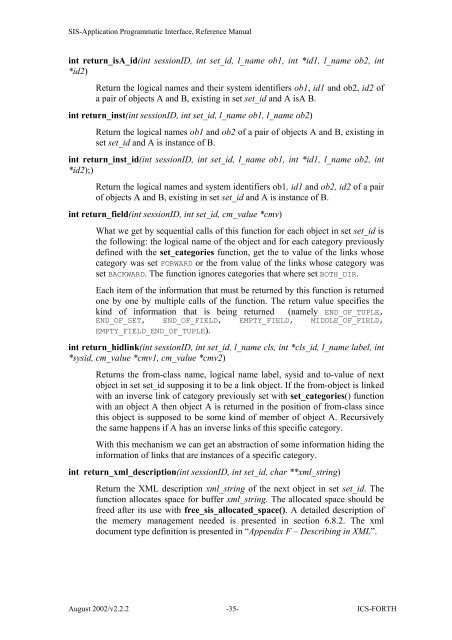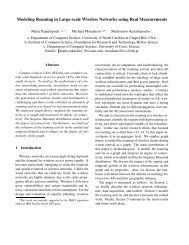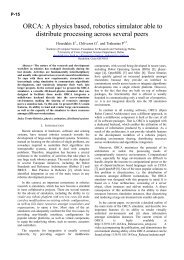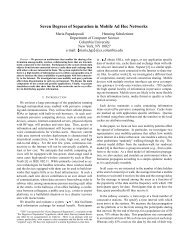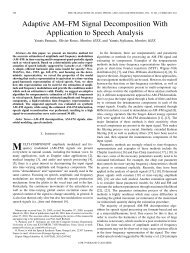SIS - Application Programmatic Interface, Reference Manual - ICS ...
SIS - Application Programmatic Interface, Reference Manual - ICS ...
SIS - Application Programmatic Interface, Reference Manual - ICS ...
Create successful ePaper yourself
Turn your PDF publications into a flip-book with our unique Google optimized e-Paper software.
<strong>SIS</strong>-<strong>Application</strong> <strong>Programmatic</strong> <strong>Interface</strong>, <strong>Reference</strong> <strong>Manual</strong><br />
int return_isA_id(int sessionID, int set_id, l_name ob1, int *id1, l_name ob2, int<br />
*id2)<br />
Return the logical names and their system identifiers ob1, id1 and ob2, id2 of<br />
a pair of objects A and B, existing in set set_id and A isA B.<br />
int return_inst(int sessionID, int set_id, l_name ob1, l_name ob2)<br />
Return the logical names ob1 and ob2 of a pair of objects A and B, existing in<br />
set set_id and A is instance of B.<br />
int return_inst_id(int sessionID, int set_id, l_name ob1, int *id1, l_name ob2, int<br />
*id2);)<br />
Return the logical names and system identifiers ob1, id1 and ob2, id2 of a pair<br />
of objects A and B, existing in set set_id and A is instance of B.<br />
int return_field(int sessionID, int set_id, cm_value *cmv)<br />
What we get by sequential calls of this function for each object in set set_id is<br />
the following: the logical name of the object and for each category previously<br />
defined with the set_categories function, get the to value of the links whose<br />
category was set FORWARD or the from value of the links whose category was<br />
set BACKWARD. The function ignores categories that where set BOTH_DIR.<br />
Each item of the information that must be returned by this function is returned<br />
one by one by multiple calls of the function. The return value specifies the<br />
kind of information that is being returned (namely END_OF_TUPLE,<br />
END_OF_SET, END_OF_FIELD, EMPTY_FIELD, MIDDLE_OF_FIELD,<br />
EMPTY_FIELD_END_OF_TUPLE).<br />
int return_hidlink(int sessionID, int set_id, l_name cls, int *cls_id, l_name label, int<br />
*sysid, cm_value *cmv1, cm_value *cmv2)<br />
Returns the from-class name, logical name label, sysid and to-value of next<br />
object in set set_id supposing it to be a link object. If the from-object is linked<br />
with an inverse link of category previously set with set_categories() function<br />
with an object A then object A is returned in the position of from-class since<br />
this object is supposed to be some kind of member of object A. Recursively<br />
the same happens if A has an inverse links of this specific category.<br />
With this mechanism we can get an abstraction of some information hiding the<br />
information of links that are instances of a specific category.<br />
int return_xml_description(int sessionID, int set_id, char **xml_string)<br />
Return the XML description xml_string of the next object in set set_id. The<br />
function allocates space for buffer xml_string. The allocated space should be<br />
freed after its use with free_sis_allocated_space(). A detailed description of<br />
the memery management needed is presented in section 6.8.2. The xml<br />
document type definition is presented in “Appendix F – Describing in XML”.<br />
August 2002/v2.2.2 -35- <strong>ICS</strong>-FORTH


